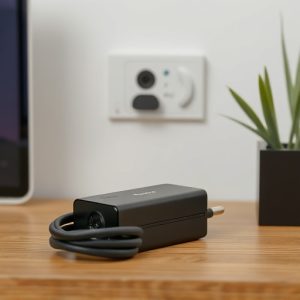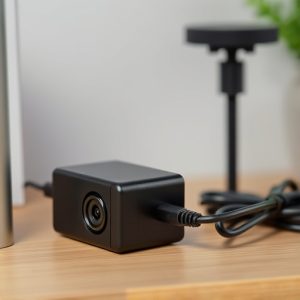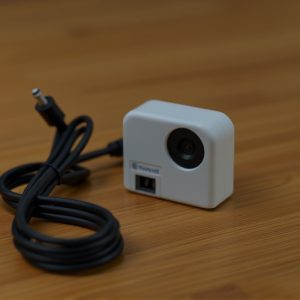Optimal Use and Setup of AC Adapter Hidden Camera with Built-in DVR Systems
The article emphasizes the critical role of AC adapters in ensuring continuous and high-quality pow…….
The article emphasizes the critical role of AC adapters in ensuring continuous and high-quality power to hidden cameras with built-in DVRs for effective surveillance systems. Matching the adapter's specifications with the camera is essential to prevent damage or performance issues, as it directly affects the reliability and integrity of the video recordings. High-quality AC adapters are crucial for maintaining uninterrupted 24/7 operation, which is vital for security purposes. These cameras offer a discreet way to monitor properties, with built-in DVR functionality that records footage onto a storage device without the need for external recording devices. The advantage of using an AC adapter is the elimination of frequent battery changes found in wireless models, ensuring a stable power supply. Additionally, the high-definition resolution of both the camera and DVR captures clear imagery, which is essential for identifying individuals or discerning crucial details. For optimal installation, the camera should be placed discreetly with a clear view, connected to the DVR via a secure cable, and linked to a display for video playback. Regular updates and checks are necessary to maintain system security and performance. The integration of AC adapters with these cameras is becoming increasingly important in modern home security strategies, offering a blend of efficiency, reliability, and discreet surveillance. Keywords: AC adapter hidden camera with built-in DVR.
Explore the essential role of AC adapters, particularly those integrated within hidden cameras with built-in DVR systems for home security. This article delves into the technical specifications crucial for optimal performance and guides you through installation and setup processes. Gain insights into best practices for leveraging these devices effectively to safeguard your premises. With an AC adapter hidden camera, transform your surveillance system into a robust protective measure.
Understanding AC Adapters: The Power Behind Your Devices
AC adapters serve as the critical link between alternating current (AC) power sources and electronic devices, efficiently converting high-voltage electricity into a form safe and usable by the device. These compact transformers are integral to the operation of a wide array of products, from household appliances to sophisticated security systems like AC adapters with hidden cameras that come equipped with built-in digital video recorders (DVRs). The role of an AC adapter in such devices is twofold: it powers the camera and the DVR, ensuring continuous recording and surveillance capabilities, while also maintaining data integrity and device functionality.
When selecting an AC adapter for a hidden camera with a built-in DVR, it’s crucial to consider compatibility with both the camera and the DVR components. The adapter must provide the correct voltage and current ratings as specified by the manufacturer to avoid damaging the device or compromising its performance. Additionally, the quality of the AC adapter can affect the reliability of the video footage captured; a high-quality adapter minimizes power fluctuations that could lead to errors in recording or playback. For users prioritizing security and surveillance, investing in a reliable AC adapter is not just an afterthought but a foundational element for the integrity and effectiveness of their hidden camera systems.
Harnessing Surveillance: AC Adapter Hidden Camera with Built-in DVR for Home Security
In the realm of home security, the integration of surveillance technology has become increasingly sophisticated, with AC adapters playing a pivotal role in maintaining a consistent power supply for monitoring devices. An AC adapter hidden camera with a built-in DVR offers a reliable and covert solution for safeguarding one’s property. Unlike traditional CCTV cameras that may be easily spotted and compromised, these discreet cameras are designed to blend seamlessly into the environment, deterring potential intruders and providing homeowners with peace of mind. The built-in DVR ensures that footage is recorded directly onto a storage device, allowing for real-time monitoring and the ability to review recordings at will. This feature is invaluable for capturing crucial evidence should an incident occur, as it eliminates the need for external recording devices and complex setup processes.
The benefits of using an AC adapter hidden camera with a built-in DVR are manifold. For one, the device operates on standard household current, which means it can run continuously without the frequent battery replacements required by wireless models. This ensures that your surveillance system is always active, providing 24/7 monitoring capability. Additionally, the high-quality resolution of both the camera and the DVR means that users can expect clear, detailed footage, which is essential for identifying individuals or discerning important details in a given situation. The compact nature of these devices also allows for easy installation in various locations around the home without drawing attention to the security system in place. With the increasing demand for smart home solutions, these AC adapter hidden cameras with built-in DVRs stand out as an integral component for modern home security strategies.
Technical Specifications: What to Look For in an AC Adapter Hidden Camera DVR System
Installation and Setup: A Step-by-Step Guide to Your AC Adapter Hidden Camera with DVR
When setting up your AC adapter hidden camera with a built-in DVR, careful installation is key to ensuring high-quality footage and security. Begin by selecting a discreet location for your camera, considering the field of view needed to capture the desired area. Ensure the camera is positioned securely to prevent any accidental movement that could affect the recording quality. Next, connect the AC adapter to the camera, plugging the other end into a power outlet. This will ensure the camera maintains a consistent power supply and doesn’t rely on batteries, which can be inconvenient to replace frequently.
Once the AC adapter is securely connected, proceed with setting up the DVR component. Connect the video output from the camera to the input of your DVR system, typically using an RCA cable or a BNC connection, depending on the equipment’s compatibility. Make sure all connections are tight to avoid signal loss. If your setup includes monitoring via a computer or television, connect the HDMI output from the DVR to the respective input on the display device. For DVR functionality, insert the provided memory card into the DVR, ensuring it is properly seated and recognized by the system. This will store the footage recorded by your hidden camera with a built-in DVR. Finally, configure the recording settings as per your requirements, such as motion detection or continuous recording. Always refer to the user manual for specific instructions tailored to your device model. By following these steps meticulously, you can ensure a successful setup and installation of your AC adapter hidden camera with a built-in DVR system.
Best Practices for Using AC Adapter Hidden Camera with Built-in DVR Systems Effectively
When integrating an AC adapter hidden camera with a built-in DVR system, it’s crucial to prioritize both the security setup and the device’s functionality. To ensure optimal performance, begin by selecting a high-quality AC adapter that matches the specifications of your hidden camera. This will prevent issues related to voltage or current inconsistencies, which could potentially compromise video quality or recording duration. Once installed, position the camera strategically to capture clear visuals without obstructing vital areas. Additionally, secure the camera and cables to avoid accidental disconnections. It’s advisable to use a surveillance kit that includes weatherproofing options if the camera will be used outdoors.
For effective monitoring, configure the DVR system to store footage on both local storage and a remote server when possible. This dual approach ensures that you have access to video evidence in case of an emergency, regardless of the device’s operational status. Regularly update the firmware of both the camera and the DVR to benefit from improved features and security patches. Furthermore, test the system regularly to ensure all components are functioning correctly and that recordings are being saved as intended. Utilizing a consistent power supply through the AC adapter minimizes the risk of unexpected interruptions, thereby enhancing the reliability of your surveillance setup.


